Alfonso X el Sabio, 1221-1284.
Cantigas de Francia
Eduardo Paniagua, Grupo de Música Antigua
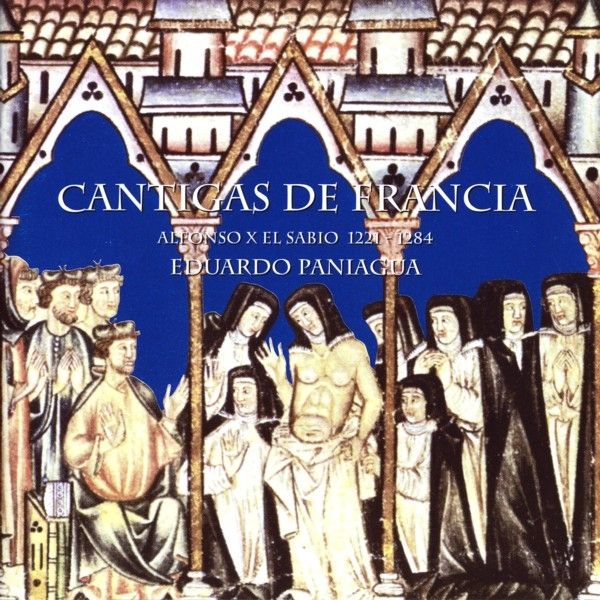
medieval.org
Sony "Hispánica" SK 60842 —
1998
Pneuma PN-520 — 2003
1. EL CLÉRIGO Y LOS LADRONES
[Sempr' aos seus val] [3:16]
CSM 102
gaita charra con chicotén, cítara, flauta tenor
2. MÉDICO DE MONTPELLIER.
De Santa Maria sinal [4:22]
CSM 123
tenor, coro — vihuela, axabeba, salterio, flauta tenor,
fídula, darbuga, tar
3. SOBRE LAS AGUAS DE MARSELLA.
A Santa Madre daquele que a pe sobelo mar [3:49]
CSM 236
tenor, bajo, coro — zanfona, chalumeaux, canno, flauta tenor, tambor
de madera, panderete, castañuelas ibicencas
4. LA PEDRADA DEL TAHÚR DE CHATEAUROUX (BOURGES).
Pois que Deus quis da Virgen fillo [8:32]
CSM 38
sopranos 1 & 2, contratenor, tenor, coro — vihuela,
fídula, flauta tenor, canno, campanil
5. EL MONJE AHOGADO
[Macar ome per folía] [3:02]
CSM 11
cálamo, zanfona, salterio, canno, flauta tenor, darbuga,
címbalos
6. EL CLÉRIGO AHOGADO EN EL SENA (PARÍS).
En todo tempo faz ben [5:14]
CSM 111
sopranos 1 & 2, contratenor, coro — arpa, cítara, flauta
doble, flauta tenor, tambor con tensores, címbalos
7. LA CAMISA INVULNERABLE DE CHARTRES.
De mui grandes periglos [8:52]
CSM 148
soprano 2, tenor, coro — cítara, chorus, fídula,
cántara
8. LA MONJA ENAMORADA DE LA ABADÍA DE
FONTEVRAULT
[Quena Virgen ben servir] [3:47]
CSM 59
fluta doble, zanfona, cántara, espadilla
9. LA VIOLA DE PEDRO DE SIGAR (ROCAMADOR).
A Virgen Santa María [6:33]
CSM 8
bajo, tenor, contratenor, coro — fídula, flauta tenor, gaita
charra con tambor, canno, pandero
10. ABADESA PREÑADA (SOISSONS).
Santa María amar [6:56]
CSM 7
contratenor, tenor, bajo — tromba marina, vihuela, axabeba, canno,
campanil
11. LAS RELIQUIAS DE LAÓN.
O que a Santa María derr algo [10:41]
CSM 35
sopranos 1 & 2, contratenor, tenor, bajo — órgano
portátil, zanfona, vihuela, flauta tenor, campanil, gong,
tabila, tar
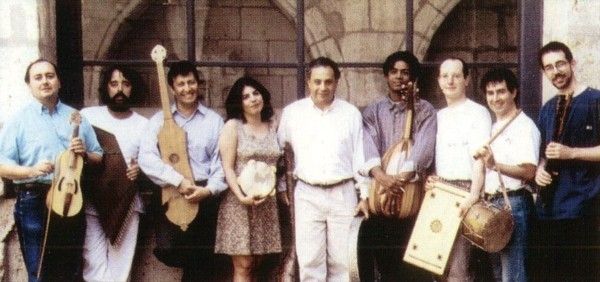
MUSICA ANTIGUA
Eduardo Paniagua
Paula Vega, soprano 1
Patricia Paz, soprano 2
Luis Vincent, contratenor, canno
César Carazo, tenor, fídula
Germán Torrellas, bajo
Felipe Sánchez, vihuela de péñola
Rafael Martín, zanfona
Javier Coble, órgano portátil
Enrique Almendros, arpa, chorus, gaita charrra con tambor y
con chicotén
Jaime Muñoz, axabeba, flauta doble, cálamo,
chalumeau
Luis Delgado,
tromba marina, tambor con tensores, pandero, panderete, tar, tambor
de madera, cántaras
Eduardo Paniagua,
salterio, cítara, flautas a bisel tenor, flauta doble,
campanil, darbuga, tabila, tar, espadilla, gong, címbalos,
castañuelas ibicencas
(Todos los instrumentos utilizados son reproducciones de originales)
[Sony]
Sonido: Tyrel - Luis Carlos Esteban y Javier Coble
Portada: Miniatura de la Cantiga 7
Fotografías de las miniaturas de las Cantigas: Carlos y Eduardo Paniagua / Oronoz
Códice original de la Biblioteca del Monasterio de El Escorial
Diseño gráfico: Luis Vincent
Producido por EDUARDO PANIAGUA
Supervisor de Hispánica: RAFAEL PÉREZ-ARROYO
℗ © 1998 SONY MUSIC Entertainment (SPAIN), S.A.
[Pneuma]
Portada: Cantiga 7
Licencidado por Sony Music Entertainment Spain, S.A.
Depósito Legal: M-10376-2003
Grabado en diciembre de 1997 y enero de 1998
Sonido: Tyrel, Luis Carlos Esteban y Javier Coble
Diseño gráfico: Pneuma
Distribución: Karonte
Producción: EDUARDO PANIAGUA • 2003 PNEUMA
English liner notes

CANTIGAS DE FRANCIA
Desde el renacimiento cultural de Carlomagno donde "parecía como
si la tierra estuviese despojándose de los harapos de la
Antigüedad, para volver a vestirse con un blanco manto de
iglesias", y la división del imperio, la Francia de los primeros
Capetos sólo alcanzaba a su pequeño ducado entre el Sena
y el Loira. El nombre evocaba el antiguo reino de los francos desde
Flandes a los Pirineos, y en los siglos X y XI fue haciéndose
роsible gracias a la historia de la realeza, que consiguió ir
uniendo en una sola nación a los pueblos bretones, provenzales,
gascones, flamencos y loreneses.
La ventaja de poseer París, el apoyo del papado y de las
internacionales ordenes monásticas, y la conquista de Inglaterra
рог los normandos en 1066, fueron situaciones favorables es para el
crecimiento y prestigio de Francia, ya que el gobernante de Inglaterra,
como duque de Normandía era vasallo del rey de Francia. Tras las
disputas entre Luis VII de Francia y Enrque II Plantagenet de
Inglaterra, ambos casados con la famosa Leonor de Aquitania, que
inclinaron la halanza a favor de Inglaterra, Felipe II de Francia
(1180-1223 ) fue superior oponente a los hijos de Enrique II
Plantagenet, el inestable Ricardo Corazón de León
(1189-1199), y Juan sin Tierra (1199-1216), recuperando todo el
territorio continental.
El rey Luis VIII de Francia (1223-1226) anexionó para su corona
el independiente condado de Toulouse con el oscuro asunto de la lucha
contra la herejía cátara о albigense. Con Luis IX de
Francia (1226-1270), hijo de Blanca de Castilla y tío de Alfonso
X, se llega a la cúspide cultural con la universidad de
París, la escuela musical de Notre Dame, el prestigio de la
santidad de su rey, el apogeo de las cruzadas a Tierra Santa, y la
veneración exaltada a santos e imágenes, y sobre todo a
Santa María, titular de cientos de iglesias y catedrales
góticas en todo el orbe cristiano.
Alfonso X (1221-1284), rey de Castilla y de León (1252-1284),
perseguidor durante dieciocho años (1257-1275) de la corona del
Sacro Imperio Romano, ha sido denominado "Emperador de la Cultura" рог
la intensidad de sus obras sobre la historia, las ciencias, el derecho
y su participación en la poesía, música,
miniaturas y arquitectura.
En su proyecto de verter en lenguas vernáculas la
sabiduría clásica de las culturas árabe, latina y
hebrea, manda elaborar los manuscritos que recopilan las vanguardias de
estos saberes. El atractivo intelectual de su corte, con expertos е
interesados de los confines de la geografía conocida,
hacían ganar cada vez más renombre para sí mismo y
para sus reinos en la Europa del siglo XIII. Frente а las obras en
lengua castellana son las poesías de las Cantigas de Santa
María, escritas en lengua galaico-portuguesa, en las que
más se refleja personalmente el poeta-Rey.
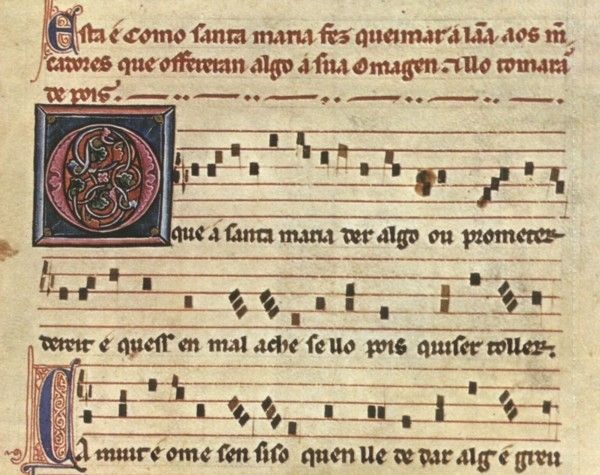 Alfonso reunió gran número de repertorios mariales
ibéricos y transpirenaicos anteriores a su época.
Destacan de entre estos últimos las fuentes francesas para las
Cantigas de los diferentes santuarios marianos: Rocamador, Soissons,
París, Chartres, etc; y de los autores: Hugo Farsitus, Gamier de
Coincy, Heman de Laon, Gobíus, Etienne de Bourbon, Vicente de
Beauvais, Jean Le Marchand, el Speculum Historiale y los miracles
provenzales.
Alfonso reunió gran número de repertorios mariales
ibéricos y transpirenaicos anteriores a su época.
Destacan de entre estos últimos las fuentes francesas para las
Cantigas de los diferentes santuarios marianos: Rocamador, Soissons,
París, Chartres, etc; y de los autores: Hugo Farsitus, Gamier de
Coincy, Heman de Laon, Gobíus, Etienne de Bourbon, Vicente de
Beauvais, Jean Le Marchand, el Speculum Historiale y los miracles
provenzales.
El presente trabajo ha tenido la aventurada selección de entre
más de ochenta cantigas del cancionero cuyos milagros suceden en
Francia, tanto en su zona norte como en los santuarios de Occitania.
1 - CSM 102. EL CLÉRIGO Y LOS LADRONES
Cantiga interpretada instrumentalmente, con esquema melódico
exclusivo en el cancionero. Narra su texto, sin localización
expresa, cómo Santa María salvó a un
clérigo de morir en una sima donde le hablan echado unos
ladrones.
2 - CSM 123. MÉDICO DE MONTPELLIER
Milagro localizado en Vitoria. El semblante de un fraile menor al morir
reflejaba el pavoroso temor de pasar a la otra vida. Otro fraile le
encendió una candela de la Virgen. La faz del moribundo
pasó de ser negra a figurar blanca sin que actuase ningún
"médico de Montpellier". Después de morir el fraile se
apareció a los compañeros indicando que la vela,
señal de Santa María, hizo huir a los demonios y de este
modo consiguió la paz.
3 - CSM 236. SOBRE LAS AGUAS DE MARSELLA
Santa María salva a una mujer que viajaba con su niño en
la galera del corsario Pero Bonifaz de Marsella, haciéndola
caminar sobre las aguas cuando naufragaron.
4 - CSM 38. LA PEDRADA DEL TAHÚR CHATEAUROUX (BOURGES)
Cantiga con esquema melódico irregular que parece la
unión de dos tonadas preexistentes, una de ritmo binario y otra
dáctilo ternario. La imagen de Santa María extiende su
brazo y recoge el de su hijo, roto рог una pedrada de un tahúr.
Estando en guerra Ricardo Corazón de León, conde
Poitiers, y Felipe II Augusto rey de Francia (1194-1198) en
Chateauroux, cerca de Bourges, el conde secularizó un monasterio
por sospecha de traición. Mala gente ocupó el lugar y un
tahúr airado con una mujer que rezaba ante una imagen en la
sacristía del templo, comenzó a tirar piedras rompiendo
un brazo del niño que tenía la Virgen. Esta, dejando caer
la flor que tenía en su mano, tomó el brazo roto para que
no cayera al suelo y castigó al jugador y a sus
compañeros. Cuando llegó el conde de Poitiers, uno de sus
caballeros herido fue curado por esta imagen. La historia de esta
Cantiga se recoge también en el "Speculum Historiale" de
Beauvais, en Gobius y en Etienne de Bourbon.
5 - CSM 11. EL MONJE AHOGADO
Cantiga interpretada instrumentalmente, es similar en cuanto a su
contenido literario a la CSM 111. Polémica entre ángeles
y demonios para apoderarse del alma de un monje que se ahogó
cuando iba a visitar a su amiga. La Virgen resucita al monje. La
construcción musical es una rareza, úmica en las Cantigas.
6 - CSM 111. EL CLÉRIGO AHOGADO EN EL SENA
Un clérigo se ahogó en el rio Sena cuando volcó el
barco que le llevaba a una cita con su amiga. Poг haber rezado con
ahínco las horas de la Virgen, esta le resucita al tercer
día, sacándole del rio.
Este milagro está recogido en más de sesenta versiones
latinas y utilizada en sermones como los atribuidos a San Anselmo de
Cantorbery. Se conocen versiones versificadas en francés,
alemán, inglés, italiano, islandés, sueco,
árabe, etíope y griego. En España lo utilizan Gil
de Zamora, Berceo y Alfonso X.
7 - CSM 148. LA CAMISA INVULNERABLE DE CHARTRES
En tiempo de Carlomagno rey de los francos se veneraha una camisa de la
Virgen, reliquia del santuario de Chartres, "Carnotum Camísia".
Las telas que tocaba esta camisa tenian la propiedad de hacer
invulnerable a quien las vistiese. Rollus, duque del ejército
normando, que vestía una de estas telas y que fue golpeado y
atravesado рог sus enemigos, permaneció vivo junto a unas
moreras, guardado de la muerte рог la Señora. La
narración está recogida por Vicente de Beauvais, Nigellus
de Lorenzo Campo, Jean Le Marchand y, en España, por Gil de
Zamora y Theophilo Braga.
8 - CSM 59. LA MONJA ENAMORADA DE LA ABADÍA DE FONTEVRAULT
Cantiga interpretada instrumentalmente. Cuando la monja enamorada va a
abandonar el convento, la imagen de la Virgen llora y un crucifijo deja
caer su mano sobre la cara de la joven, dejándola sin sentido.
9 - CSM 8. LA VIOLA DE PEDRO DE SIGAR (ROCAMADOR)
Cantiga típica de este repertorio de cuatro frases
melódicas . Milagro del santuario de Rocamador recogido
también por Hugo Farsitus en el libro "De Miraculis Virginia
Rupis Amatorís", y рог Gamier de Coincy. El protagonista es
Pedro de Sigrar, localidad cercana a Colonia, un juglar que cantaba
"lais" a la Virgen y tocaba la viola. Un día, ante la imagen de
Santa María, le pidió una candela para tener con
qué cenar. La Virgen hizo que una vela de su altar se posase en
la viola. El tesorero del templo censuró al juglar y creyendo
que robaba la candela se la quitó. Cuando sucedió lo
mismo varias veces la gente comprendió el milagro y
protestó al tesorero, que pidió perdón.
10 - CSM 7. ABADESA PREÑADA (SOISSONS)
Con esquema melódico único dentro del cancionero, es una
de las diez Cantigas en que aparece el santuario de Soissons. Cuente la
historia de una abadesa de un monasterio cluniacense en tierra de
Bolonia, que tentada рог el mayordomo quedó embarazada. Las
monjas al notarlo, debido a que la abadesa era muy severa, fueron a
acusarla al obispo del lugar cuando este venía desde Colonia. La
abadesa pidió ayuda a la Madre de Dios, y esta hizo sacarle el
hijo y le mandó a criar a un ermitaño de Soissons. El
obispo la ordenó desnudarse y observandola no pudo acusarla.
Esta Cantiga, que recuerda a las de. cantares de burlas y escarnio del
Rey Alfonso X. aparece en las colecciones de milagros francesas "
Speculurn Historíale del Bellovacense", y los "Miracles
Provenzales". En España la recoge Berceo, Gil de Zamora y los
"Miracles" catalanes.
11 - CSM 35. LAS RELIQUIAS DE LAÓN
Cuenta esta Cantiga el poder de las reliquias y el castigo a quienes no
cumplen sus promesas a la Virgen. Un incendio destruye una iglesia de
Laón en la que se guardaban reliquias de Santa María en
un arca de oro (leche y cabellos de la Virgen). El deán Maestre
Bernardo, sale con las reliquias pare conseguir dinero para la
reconstrucción del templo, primero por Francia y después
hacia Inglaterra en la nave de Colistanus, que viajaba con mercaderes
de Flandes y de París. Son atacados рог galeras corsarias y
gracias a las reliquias se salvan. Los mercaderes incumplen las
promesas hechas durante el peligro, y la Virgen les castiga con un rayo
que quema la lana que transportaban. Al final los mercaderes entregan
las riquezas prometidas.
Veintitrés estrofas con ciento treinta y tres versos tiene esta
Cantiga "grande" (las que terminan en el número cinco). Su
historia también es recogida en "De Miraculis Landuniensis" de
Herman de Laón y en Gil de Zamora y Gautier de Coincy.
Eduardo Paniagua
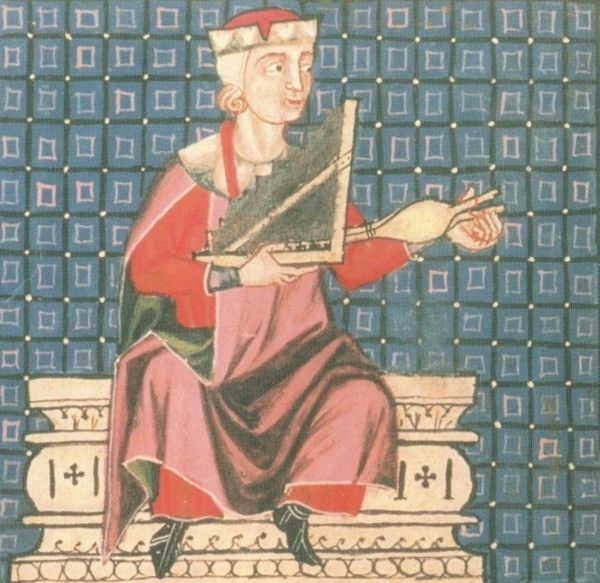
CANTIGAS OF FRANCE
Since Charlemagne's cultural renaissance,
where "it seemed as if the earth was casting off the rags of antiquity
to dress again in a white cloak of churches", and the division of the
Empire, the France of the first Capets only comprised their little duchy
between the Seine and the Loire. The name evoked the old kingdom of the
Franks from Flanders to the Pyrenees, and in the 10th and 11th
centuries it gradually became possible thanks to the history of royalty,
which managed to unite as one nation peoples such as the Bretons,
Provençals, Gascons, Flemish and Loirens.
The advantages of
possessing Paris, the support of the papacy and of the international
monastic orders, and the conquest of England by the Normans in 1066 were
favourable conditions for the growth and prestige of France, since the
ruler of England, as Duke of Normandy, was vassal to the king of France.
After the disputes between Louis VII of France and Henry II Plantagenet
of England, both of them married to the famous Eleanor of Aquitaine,
which favoured England, Philip II of France (1180-1223) was a stronger
opponent to Henry II Plantagenet's children: the unbalanced Richard
Lionheart (1189-1199), and John Lackland (1199-1216), thus recovering
all the continental territory.
The king Louis VII of France
(1223-1226) annexed to his crown the independent county of Toulouse with
the dark matter of the struggle against the Cathar or Albigensian
heresy. With Louis IX of France (1226-1270), the son of Blanche of
Castile and the uncle of Alfonso X, a cultural summit is reached with
the University of Paris, the music school of Notre-Dame, the prestige of
the sanctity of its king, the success of the crusades to the Holy Land,
and the exalted veneration of saints and images, above all of Saint
Mary, patron of hundreds of gothic churches and cathedrals all over the
Christian world.
Alfonso X (1221-1284), king of Castile and
León, pursuer for eighteen years (1257-1275) of the crown of the Holy
Roman Empire, has been labelled "Emperor of Culture" because of the
intensity of his works on History, Science and Law, and because of his
participation in poetry, music, book illumination and architecture.
As
part of his project of rendering into the vernacular the classical
knowledge of the Arabic, Latin and Hebrew cultures, he ordered the
production of some manuscripts comprising the most advanced ideas in
these fields. The intellectual cast of his court, with experts and
connoisseurs from the furthermost parts of the known world, gradually
made himself and his kingdoms more and more renowned in the Europe of
the 13th century.
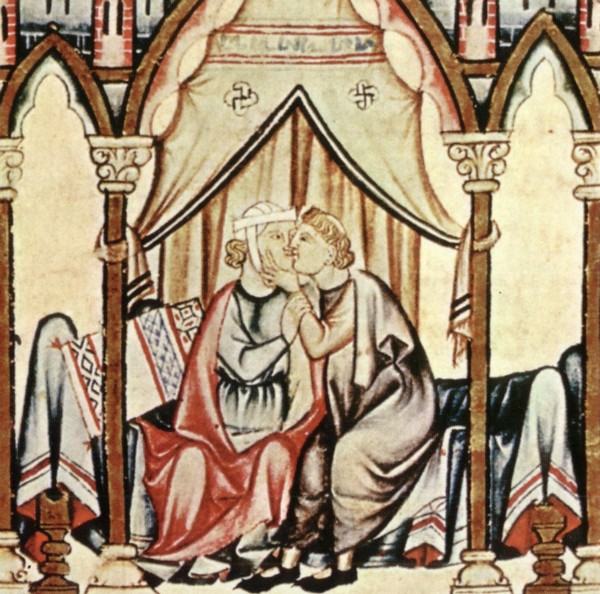 It is in the poems from the Cantigas of Santa
Maria, written in the Galician-Portuguese language, rather than the
works written in Castillian, that the poet-king is personally best
reflected.
It is in the poems from the Cantigas of Santa
Maria, written in the Galician-Portuguese language, rather than the
works written in Castillian, that the poet-king is personally best
reflected.
Alfonso gathered a great number of Iberian and
Transpyrenean Marian works from before his time. Among the latter it is
worth pointing out the French sources for the Cantigas of the different
Marian sanctuaries: Rocamadour, Soissons, Paris, Chartres, etc: and the
authors: Hugo Farsitus, Gautier de Coincy, Herman de Laon, Gobius,
Etienne de Bourbon, Vincent de Beauvais, Jean Le Marchand, the Speculum
Historiale and the Provençal miracles.
The present work has made a
daring selection from among more than eighty cantigas from the songbook
whose miracles happen in France, both in the North and in the Occitan
sanctuaries.
1. CSM 102. THE CLERGYMAN AND THE ROBBERS
Cantiga
interpreted instrumentally, with a melodic scheme exclusive to the
songbook. Its text narrates, without an explicit location, how Saint
Mary saved a clergyman from dying in a pit that some robbers had thrown
him into.
2. CSM 123. THE DOCTOR OF MONTPELLIER
A
miracle located in Vitoria. The face of a minor friar on dying
reflected the dreadful fear of passing over to the other life. Another
friar lit a candle to the Virgin for him. The dying man's face turned
from black to white without the action of any "doctor of Montpellier".
After his death, the friar appeared to his partners and pointed out that
the candle, Saint Mary's sign, made the demons flee, and thus he
achieved peace.
3. CSM 236. THE WATERS OF MARSEILLES
Saint
Mary saves a woman who was travelling with her child in the galley of
the corsair Pero Bonifaz of Marseilles, by making her walk on the waters
after their ship sank.
4. CSM 38. THE STONE THROWN BY THE GAMBLER OF CHATEAUROUX (BOURGES)
Cantiga
with an irregular melodic scheme which looks like two pre-existing
tunes put together: one with a binary rhythm; the other, a ternary
dactyl. The image of Saint Mary puts out Her arm and picks up Her Son's,
broken by the stone thrown by a gambler. When Richard Lionheart, Earl
of Poitiers, was at war, and Philip Augustus II, king of France
(1194-1198), in Chateauroux, near Bourges, the earl secularised a
monastery under suspicion of treason. Wicked people occupied the place,
and a gambler who was angry with a woman who prayed in front of an image
in the sacristy started to throw stones and broke the arm of the Child
the Virgin was holding. She let go of the flower She had in Her hand and
grabbed the broken arm to stop it touching the ground, and punished the
gambler and his partners. When the Earl of Poitiers arrived, one of his
injured knights was cured by this image. The story of this cantiga also
features in Beauvais's "Speculum Historiale", in Gobius and in Etienne
de Bourbon.
5. CSM 11. THE DROWNED MONK
Cantiga
interpreted instrumentally: it is similar to CSM 111 in literary
content. Fight between angels and demons to get hold of the soul of a
monk who drowned when he was on his way to visit his girlfriend. The
Virgin resurrects the monk. The musical structure is a rarity, unique in
the Cantigas.
6. CSM 111. THE CLERGYMAN DROWNED IN THE SEINE (PARIS)
A
clergyman drowned in the river Seine when the boat which was taking him
to a tryst with his girlfriend overturned. Because he had prayed the
hours of the Virgin with great intentness, She resurrected him on the
third day and took him out of the river. This miracle is collected in
more than sixty Latin versions and has been used in sermons such as
those attributed to Saint Anselm of Canterbury. There are known
versified versions in French, German, English, Italian, Icelandic,
Swedish, Arabic, Ethiopian and Greek. In Spain it is used by Gil de
Zamora, Berceo and Alfonso X.
7. CSM 148. THE INVULNERABLE SHIFT OF CHARTRES
In
the time of Charlemagne -king of the Franks-, people revered a shift of
the Virgin, a relic kept in the sanctuary of Chartres, "Carnotum
Camisia". The clothes touched by this shift had the power to make
whoever wore them invulnerable. Rollus, duke of the Norman army, who was
wearing some of these clothes, was hit and run through by his enemies'
swords but stayed alive next to some blackberry bushes, spared from
death by the Lady. The narration is collected by Vincent de Beauvais,
Nigellus de Lorenzo Campo, Jean Le Marchand and, in Spain, by Gil de
Zamora and Teophilo Braga.
8. CSM 59. THE ENAMOURED NUN OF FONTEVRAULT ABBEY
Cantiga
interpreted instrumentally. When the enamoured nun is about to abandon
the convent, the image of the Virgin weeps, and that on a crucifix drops
its hand on the young woman's face, leaving her unconscious.
9. CSM 8. PETER OF SIGRAR'S VIOL (ROCAMADOUR)
Typical
cantiga in this repertoire with four melodic phrases. The miracle of
the Rocamadour sanctuary, also collected by Hugo Farsitus in the book
"De Miraculis Virginis Rupis Amatoris", and by Gautier de Coincy. The
protagonist is Peter of Sigrar, a place near Cologne, a minstrel who
sang "lais" to the Virgin and played the viol. One day, in front of the
image of Saint Mary, he asked Her for a candle to dine by. The Virgin
made one of the candles from her Altar alight on his viol. The temple
treasurer criticised the minstrel and, in the belief that he had stolen
the candle, he took it away from him. After the same thing had happened a
few times, people understood the miracle and told off the treasurer,
who had to apologise.
10. CSM 7. PREGNANT ABBESS (SOISSONS)
With
a melodic scheme unique within the songbook, it is one of the ten
cantigas in which the sanctuary of Soissons appears. It relates the
story of an abbess front a Cluniac monastery in Boulogne, who, tempted
by the butler, became pregnant. When the nuns noticed it, and since the
abbess was extremely severe, they resorted to the local bishop to accuse
her, when he was on his way back from Cologne. The abbess begged the
Mother of God for help, and She had her child taken out and brought up
by a hermit from Soissons. The bishop ordered her to undress and, on
examining her, was unable to accuse her.
This cantiga, which reminds
us of king Alfonso X's songs of jeering and derision, appears in the
French collections of miracles "Speculum Historiale of the Bellovacense"
and the "Provençal Miracles". In Spain it is collected by Berceo, Gil
de Zamora and the Catalan "Miracles".
11. CSM 35. THE RELICS OF LAON
This
cantiga relates the power of relics and the punishment deserved by
those who do not keep their promises to the Virgin. A fire destroyed a
Laon church which held relics of Saint Mary in a gold coffer (milk and
hair of the Virgin). The dean Master Bernard set off with the relics to
obtain money for the reconstruction of the church, first around France
and then to England, in the ship of Colistanus, who was travelling with
merchants from Flanders and Paris. They were attacked by corsair
galleys, and were saved by the relics. The merchants broke the promises
made during the moments of danger, and the Virgin punished them with a
thunderbolt that burnt out the wool they transported. In the end the
merchants handed over the promised riches.
This "great" cantiga has
twenty three verses with a hundred and thirty three lines (which finish
in the number five). Its story is also collected in Herman de Laon's "De
Miraculis Landuniensis" and in Gil de Zamora and Gautier de Coincy.
EDUARDO PANIAGUA, Translation: Santiago Sanz
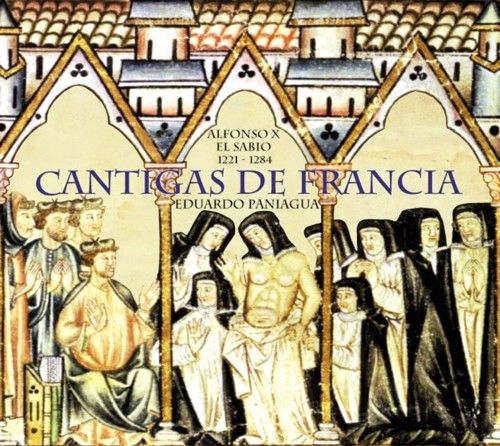



 Alfonso reunió gran número de repertorios mariales
ibéricos y transpirenaicos anteriores a su época.
Destacan de entre estos últimos las fuentes francesas para las
Cantigas de los diferentes santuarios marianos: Rocamador, Soissons,
París, Chartres, etc; y de los autores: Hugo Farsitus, Gamier de
Coincy, Heman de Laon, Gobíus, Etienne de Bourbon, Vicente de
Beauvais, Jean Le Marchand, el Speculum Historiale y los miracles
provenzales.
Alfonso reunió gran número de repertorios mariales
ibéricos y transpirenaicos anteriores a su época.
Destacan de entre estos últimos las fuentes francesas para las
Cantigas de los diferentes santuarios marianos: Rocamador, Soissons,
París, Chartres, etc; y de los autores: Hugo Farsitus, Gamier de
Coincy, Heman de Laon, Gobíus, Etienne de Bourbon, Vicente de
Beauvais, Jean Le Marchand, el Speculum Historiale y los miracles
provenzales.
 It is in the poems from the Cantigas of Santa
Maria, written in the Galician-Portuguese language, rather than the
works written in Castillian, that the poet-king is personally best
reflected.
It is in the poems from the Cantigas of Santa
Maria, written in the Galician-Portuguese language, rather than the
works written in Castillian, that the poet-king is personally best
reflected.